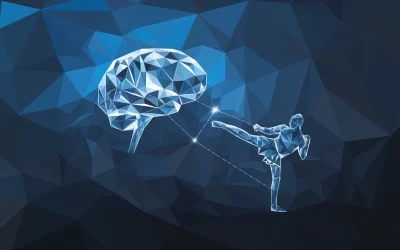Clinching is integral to Muay Thai fighting, allowing fighters to control their opponent at close range. While many fighters rely primarily on grips and swimming motions with their arms, the head can be an extremely effective and often overlooked weapon in the clinch. Using your head properly against your opponent’s can significantly hinder their movement and power, making it easier for you to manipulate them. This article will explore the basics and benefits of using your head effectively during the Muay Thai clinch.
Keep Your Head Up
Many novice clinchers make the mistake of allowing their head to drift too far forward during clinch exchanges. This gives the opponent an easy handle to grip and control your head. The most essential first adjustment is to bring your shoulders up high into a tight guard while keeping your chin down and posture upright.
Drive Your Head Offline
Once you have closed down the gap presented by hunching over, you can begin actively using your head to disrupt your opponent. Even gently driving your head into the side of their jaw or neck can make it much harder for them to generate power. Striving to get your opponent’s head offline removes their leverage and balance, allowing you to manoeuvre them more easily.
Transition Angles
In addition to weakening your enemy’s structure, driving your head offline opens opportunities to take dominant angles. If you have secured a lock but cannot break free, try burrowing your crown under their chin and pushing upward. This bends them into a poor posture, making it more straightforward to spin behind or off-balance them. Likewise, slipping under the jaw and driving your head forcefully upward or sideways can cause them to break posture and destabilise the spine.
Shorten the Range
While clinching occurs chest-to-chest, integrating your head happens at an even closer range. Get as near as possible before initiating head movement for maximum disruption. Make your head strike tiny yet constant collisions rather than massive, telegraphed blows—this maintains pressure without opening yourself up. If a smaller opponent has you smothered, work at finding angles to connect your forehead or crown underneath their chin. Taller fighters can often slide the side of their head against the enemy’s jawline.
Benefits Of Head Control
Enhanced Balance Disruption
Disturbing the opponent’s balance should be your foremost goal during any clinch. Forcing their posture offline hampers balance and strips away leverage for throwing techniques or strikes. Mixing continual head pressure to their neck and jaw makes it exponentially harder to regain equilibrium.
Minimized Striking Targets
Hunching over with sloped shoulders and a tucked chin protects vital strike points like the jaw and temples. It also eliminates the standing collar grip opponents use to control your movement. With your head kept high in the clinch, opponents have fewer openings to attack.
Uninterrupted Vision
Burying your head against the opponent obstructs their sight lines for landing elbows or planning takedowns. If you keep your crown pressed near or under their chin, your vision remains unobscured. Denying their visual cues impedes response time, magnifying the impact of driving their posture offline.
Maximized Leverage
Though the neck offers less raw power than body or leg locks, gaining head domination gives a better mechanical advantage for steering the enemy. Our heads are susceptible to positioning, so even subtle direction changes get amplified into losing integrity through the spine and hips. Practised clinchers rely heavily on neck manipulation in conjunction with under and overlook.
Universal Principle of Head Position
The concepts of dominant angles and head control are found universally across grappling arts. Elite Greco-Roman wrestlers are masters of using their heads to wedge inside an opponent and unbalance them. The principles remain the same—once you have the head position, drive forcefully while using minimal strength. This shows the timeless nature of fundamental martial tactics.
Apex MMA incorporates the head control and positioning principles outlined here into all levels of clinch training. Try a beginner Muay Thai class or a seven-day free trial to experience these techniques firsthand.





0 Comments